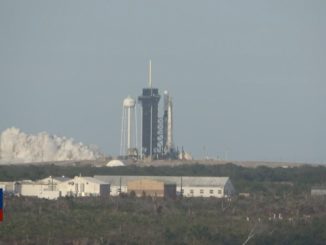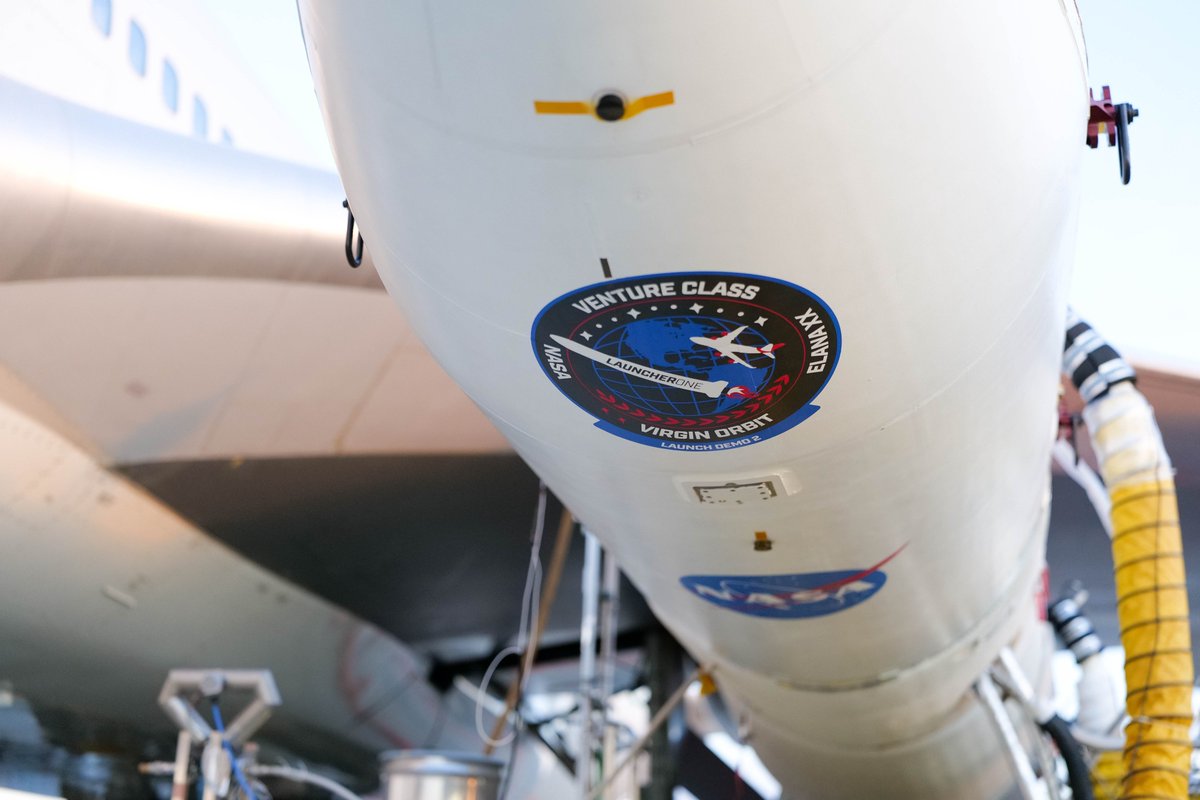
On its second launch attempt after a propulsion problem prevented its light-class air-dropped rocket from reaching space last year, Virgin Orbit will try to deliver 10 experimental CubeSats into orbit as soon as Sunday on a mission booked by NASA five years ago for $4.7 million.
Virgin Orbit’s four-hour launch window opens at 1 p.m. EST (10 a.m. PST; 1800 GMT). The company says it will not provide a public live video stream of the launch, citing logistical difficulties with streaming the rocket’s drop and ignition over the Pacific Ocean off the coast of Southern California.
The mission set to launch Sunday, which Virgin Orbit calls “Launch Demo 2,” is the second flight of the company’s LauncherOne rocket
The LauncherOne rocket measures 70 feet (21 meters) long and has two stages, both powered by single engines consuming kerosene and liquid oxygen propellants. Fully loaded, the rocket weighs about 57,000 pounds, or nearly 29 tons, according to Virgin Orbit.
The first orbital launch attempt with the LauncherOne rocket ended seconds after it began last May. Virgin Orbit said a break in a liquid oxygen feed line to the LauncherOne’s first stage engine caused the failure a few seconds after the engine ignited.
The LauncherOne vehicle can deliver up to 1,100 pounds (500 kilograms) of payload to a low-altitude equatorial orbit, or up to 661 pounds (300 kilograms) to a 310-mile-high (500-kilometer) polar orbit, according to Virgin Orbit.
Virgin Orbit is seeking to join Rocket Lab as the only companies in a new wave of privately-funded smallsat launch providers to successfully place a payload into orbit. Astra, another launch startup, successfully launched a rocket into space from Alaska last month, but the upper stage shut down prematurely just shy of orbital velocity.
Rocket Lab successfully reached orbit for the first time in 2018. The company’s Electron rocket family has launched 17 times to date, with two failures, deploying nearly 100 small satellites for commercial clients, NASA, and the U.S. military.
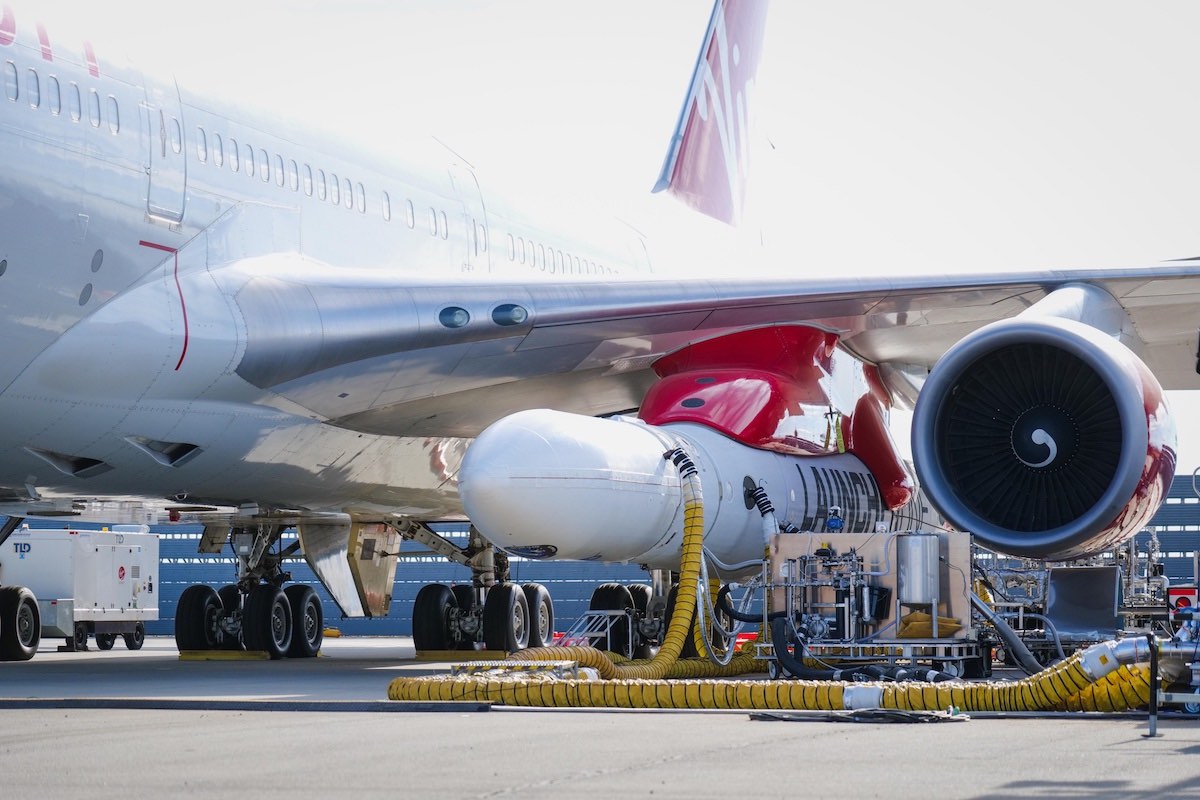
Virgin Orbit’s LauncherOne is still in its test phase.
“It’s important that we note that this is a test launch,” said Dan Hart, Virgin Orbit’s CEO. “Any early launches of a launch system carry a certain amount of risk.”
The inaugural LauncherOne mission last year carried a small passive satellite named Starshine 4, which Virgin Orbit gave a free ride. The spherical 40-pound (18-kilogram) satellite was destroyed when the rocket fell back into the Pacific Ocean after suffering a propulsion failure.
NASA is Virgin Orbit’s first paying customer. The space agency booked the mission in 2015 with Virgin Galactic, Virgin Orbit’s previous parent company, through the Venture Class Launch Services program. NASA established the VCLS program to provide rides to orbit for small research nanosatellites, and help give business to startup companies developing smallsat launchers.
The VCLS missions are “intended to be demonstration flights,” according to Scott Higginbotham, a mission manager in the Launch Services Program at NASA’s Kennedy Space Center.
NASA solicits proposals from U.S. research and educational institutions for CubeSat experiments through the CubeSat Launch Initiative. The agency pays for the launch of the CubeSats it selects, while the spacecraft themselves are typically funded through other sources.
Higginbotham said the “selected CubeSats flying on the VCLS missions are all highly risk tolerant and our contract has no requirement for a successful flight prior to ours. As such, we are comfortable being the customer for Virgin Orbit’s next launch.”
Hart, Virgin Orbit’s chief executive, said in a pre-launch press briefing that NASA engineers have been able to offer “another set of eyes” to review the company’s designs and processes. NASA has provided independent reviews of Virgin Orbit’s guidance, navigation, and control systems, liquid oxygen handling technology, and helped create technologies used on Virgin Orbit’s engines, Hart said.
Although there are 10 small satellites on-board, the prime objective of Virgin Orbit’s Launch Demo 2 mission is to “characterize the performance of the system and to get the data as we go through the sequence of events,” Hart said.
“We have what we consider NASA’s more risk-tolerant payloads, but from our point of view, they’re real payloads, and we want to get them to the right place,” Hart said. “It’s a new system, and the objective of a demo flight is to get the data on the system. So getting the data is internally our primary objectives, and our success criteria.”
The total mass of the 10 CubeSat payloads on LauncherOne, including adapters and harnessing, is approximately 253 pounds (115 kilograms), according to Kendall Russell, a Virgin Orbit spokesperson.
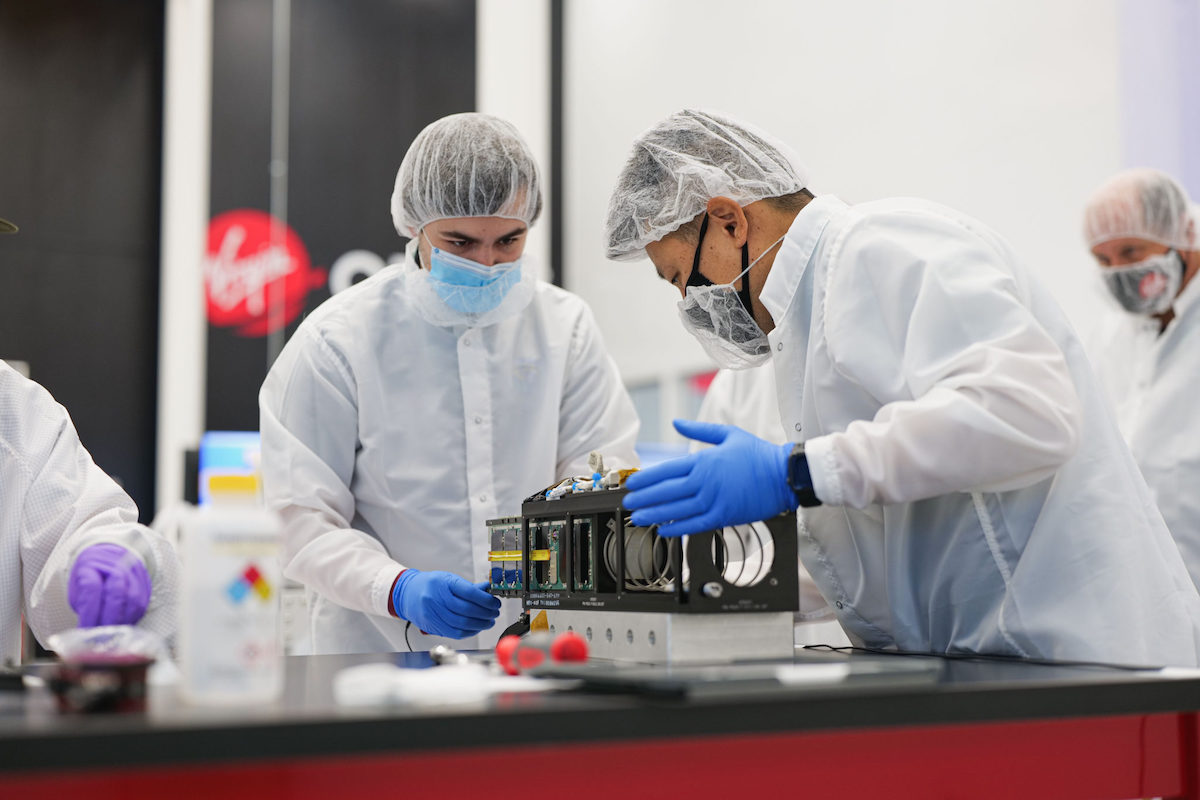
The LauncherOne rocket is targeting a roughly circular 310-mile-high (500-kilometer) polar orbit. “Given that this is a test flight, we and our customers will be extremely pleased to reach any stable orbit,” Russell said.
NASA calls the mission ELaNa-20, or the Educational Launch of Nanosatellites-20 mission.
The 10 CubeSats aboard Virgin Orbit’s Launch Demo 2 mission were built by university students and NASA researchers. Here’s an overview of the CubeSat payloads provided by NASA and Virgin Orbit:
- CACTUS-1 – Capital Technology University, Laurel, Maryland: A 3U CubeSat carrying out two technology demonstrations. The primary payload, TrapSat, is tackling the issue of space debris by using aerogel to capture and profile orbiting microdebris. The mission also includes the first secondary stand-alone payload for a CubeSat, the Hermes module, which demonstrates commanding via Internet as an cost-saving communications and command subsystem for gathering scientific data.
- CAPE-3 – Unversity of Louisiana Lafayette, Louisiana: This educational mission will fly the Smartphone CubeSat Classroom, which allows anyone with a smartphone to set up a ground station with a kit. Interactive educational activities will give students the ability to interact with the CubeSat via an app on their smartphone and use their smartphone to design their own CubeSat experiments.
- EXOCUBE-2 – California Polytechnic University, San Luis Obispo, California: This 3U CubeSat is equipped with a space weather platform that will measure a number of atomic and ionic substances in the exosphere. Knowledge of the composition and the current state of activity in the exosphere can be useful in the prediction of space weather phenomena in order to forecast potential effects on satellite communications and spacecraft performance.
- MiTEE – University of Michigan, Ann Arbor, Michigan: MiTEE is a series of two CubeSat missions developing the capability to deploy a pico/femto (i.e. very small) satellite-tether system. The missions will allow students to work on a real-world, research-driven mission to assess the key dynamics and electrodynamic fundamentals of a very short tether system for flying pairs of smallsats.
- PICS – Brigham Young University, Provo, Utah: A pair of two satellites, PICS is a technology demonstration of a spacecraft that can perform inspection, maintenance and assembly on another spacecraft. The two flight systems deployed simultaneously will enable the collection of image data from each other as well as the parent spacecraft.
- PolarCube – University of Colorado at Boulder, Boulder, Colorado: PolarCube is a small radiometer that will collect Earth surface and atmospheric temperature data. Its purpose is to collect brightness temperature spectra at a low cost, useful for applications like storm cell observations and the study of sea ice fractions near the poles.
- Q-PACE – University of Central Florida, Orlando, Florida: Q-PACE will facilitate long-duration microgravity experiments to study collisions in the early protoplanetary disk. The CubeSat will observe low-velocity collisions between cm-scale and smaller particles, addressing the decades-old question of how bodies grow past the meter-size barrier into planetesimals that can become planets through gravitational accretion.
- RadFXSat-2 – Vanderbilt University, Nashville, Tennessee: RadFxSat-2 has two mission objectives: to study the effects of space radiation on a specific kind of Static Random Access Memory (SRAM) for the purpose of validating single-event error rate predictions, and to test a design for two-way amateur radio communications.
- TechEdSat-7 – NASA Ames Research Center, Moffett, California: The overall goal of TechEdSat is to evaluate, demonstrate, and validate two new technologies for future experiments aboard smallsats. After 60 days in orbit, the satellite will be commanded to quickly re-enter the atmosphere utilizing a new device called an Exo-Brake.
Virgin Orbit teams at Mojave Air and Space Port in California planned to load RP-1 kerosene fuel into the LauncherOne rocket Saturday night, then pump super-cold liquid oxygen into the vehicle early Sunday.
The rocket is carried under the left wing of Virgin Orbit’s 747 jumbo jet, named “Cosmic Girl,” which will taxi to the runway and take off from Mojave and head west over California’s coastal mountain ranges, then turn south to fly over the Pacific Ocean west of Santa Barbara, heading for a drop point near California’s Channel Islands around 100 miles (160 kilometers) west-southwest of Long Beach.
Chief pilot Kelly Latimer, a former U.S. Air Force test pilot, will fly the 747 through the rocket’s drop box, then enter a race track pattern to loop back around line up for launch on a southeasterly heading west of San Nicolas Island, which is owned by the U.S. Navy.
Latimer will command the airplane — crewed by two pilots and two launch engineers — onto climb angle of more than 25 degrees. The nearly 30-ton rocket will be released from a pylon under the 747’s left wing during the pull-up maneuver at an altitude of around 35,000 feet (nearly 10,700 meters).
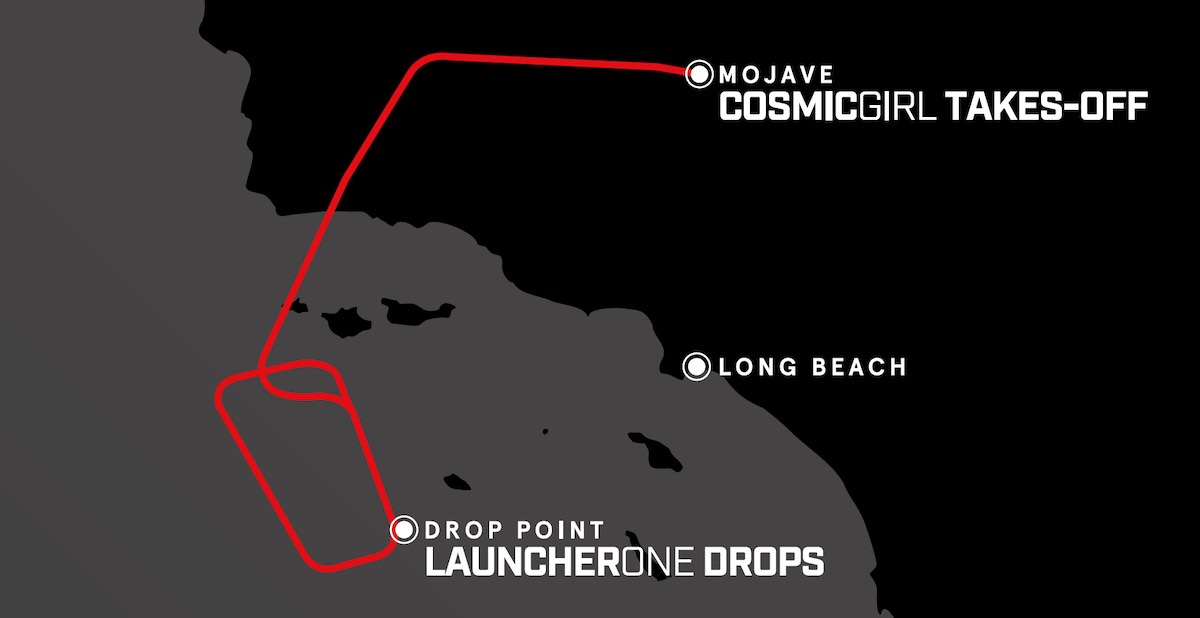
Around five seconds after release, the rocket’s kerosene-fueled NewtonThree engine will ignite with 73,500 pounds of thrust to begin climbing into orbit. After a three-minute burn, the rocket’s first stage will shut down and fall into the Pacific Ocean, giving way to LauncherOne’s second stage, powered by a NewtonFour engine generating about 6,000 pounds of thrust.
Two firings of the second stage are planned on the Launch Demo 2 mission, with the second burn occurring after the rocket flies over Antarctica to head back north over the Indian Ocean. If all goes according to plan, the 10 CubeSats will release from the deployers about 56 minutes into the mission.
Here’s an overview of the launch timeline provided by Virgin Orbit:
- Drop+00:00: LauncherOne release from Cosmic Girl
- Drop+00:05.2: NewtonThree main engine start (MES)
- Drop+03:00.5: First stage throttle down
- Drop+03:07.4: Main engine cutoff (MECO)
- Drop+03:10.4: Stage separation
- Drop+03:14.4: NewtonFour engine start (SES-1)
- Drop+03:39.4: Payload fairing separation
- Drop+09:10.1: NewtonFour engine cutoff (SECO-1)
- Drop+09:17.1: BBQ roll (for thermal balance during coast)
- Drop+49:22.7: Orient second stage for restart
- Drop+55:45.7: NewtonFour engine start (SES-2)
- Drop+55:50.0: NewtonFour engine cutoff (SECO-2)
- Drop+56:50.0: Payload separation
With its headquarters and rocket factory in Long Beach, Virgin Orbit is part of Richard Branson’s Virgin Group and a sister company to Virgin Galactic, which is targeting the suborbital space tourism market with the SpaceShipTwo rocket plane.
Virgin Orbit is not setting out to launch people. Instead, the company aims to offer small satellite operators — ranging from NASA and research institutions, to the U.S. and foreign militaries, to commercial startups — dedicated launch opportunities from sites around the world.
“Our first customer on this flight, NASA, has done some incredible things with small satellites, and we really look forward to pushing forward with NASA in exploring our solar system, our universe, and our Earth with small satellites,” Hart said. “NASA is moving toward using small satellites as a more cost-effective way of doing Earth science.”
The use of an air-launched rocket deployed from a Boeing 747 carrier jet comes with some limitations and technical challenges, but Virgin Orbit says it gives the company flexibility in where it launches and the orbits it can reach.
In addition to the company’s primary launch base at Mojave, California, Virgin Orbit plans launches from Guam, and is studying basing missions in the United Kingdom and other sites around the world.
Email the author.
Follow Stephen Clark on Twitter: @StephenClark1.


